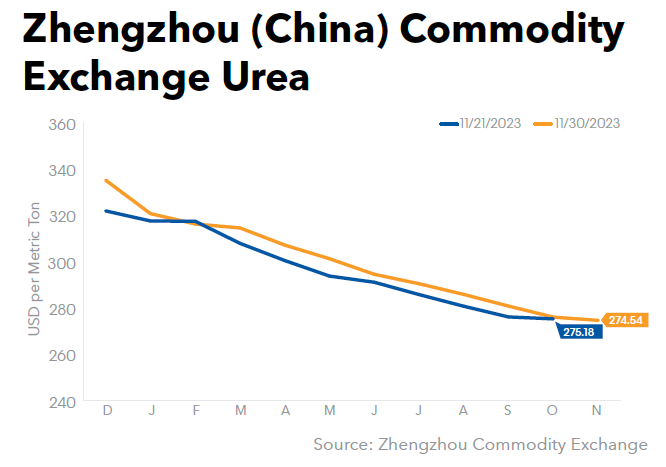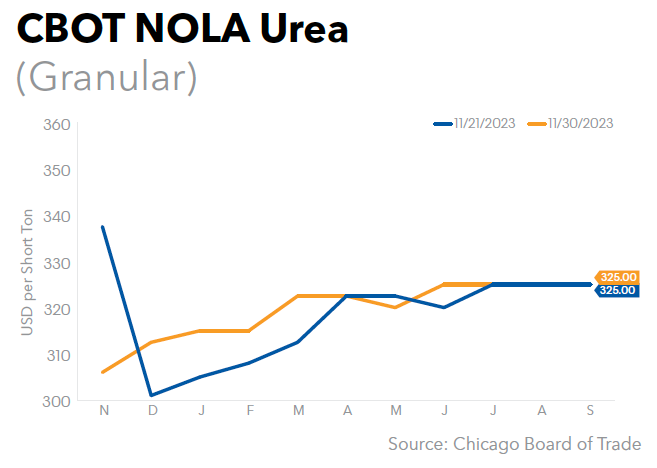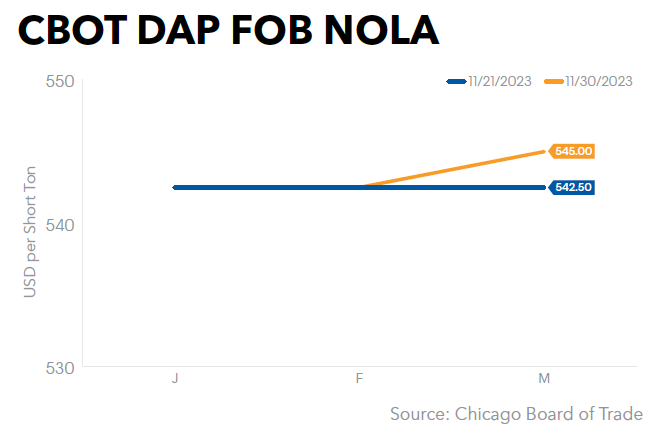


Casablanca-based OCP Group SA reported a 60% drop in EBITDA, to MAD17.18 billion ($1.7 billion) for the nine months to Sept. 30, 2023, down from MAD42.96 billion ($4.31 billion) during the same period last year, according to a Nov. 20 earnings statement.
Nine-month revenue fell 32% year-over-year, to MAD61.04 billion ($6.03 billion) from MAD89.54 billion ($8.96 billion) last year, with OCP attributing the drop to price declines across all its product categories compared to “the exceptional price environment” of 2022.
“OCP’s nine-month results were bolstered by the group’s third-quarter performance, which represented a strong sequential rebound compared to second-quarter levels,” said OCP Group Chairman and CEO Mostafa Terrab.
He noted favorable market trends that began in August and continued through September and into the fourth quarter, reflecting “gradually increasing product prices, supported by strengthening of demand in major importing regions.”
Nine-month fertilizer revenues were 29% lower year-over-year in US dollar currency, while phosphoric acid revenues decreased by 51% and phosphate rock revenues were down by 42%. OCP attributed the downturns to lower year-over-year prices and lower export volumes to key importing regions.
However, the group said export volumes “substantially rebounded” during the third quarter, reflecting sales delays in rock and acid experienced during the first half of 2023. Fertilizer sales accounted for 69% of OCP’s 2023 nine-month revenues, up from 65% in the same prior-year period.
The group said it gained “significant traction” for its TSP product, with TSP sales volumes up 20% year-over-year, to 1.2 million mt from 1.0 million mt in last year’s nine-month period and 0.9 million mt in the first nine months of 2021.
OCP’s total nine-month fertilizer sales volumes (TSP/DAP/MAP/NPK/NPS) reached 7.7 million mt, a 7% increase from last year’s 7.2 million but down from 8 million mt in 2021.
OCP said the first of three new fertilizer production lines at Jorf Lasfar were completed in the second quarter and it is currently ramping up production of TSP. Two other lines are expected to begin operation in early 2024.
OCP Revenues by Product ($ million)
| Product | 9M-2023 | 9M-2022 | % change |
| Phosphate Rock | 847 | 1,461 | (42) |
| Phosphoric Acid | 456 | 931 | (51) |
| Fertilizers | 4,168 | 5,841 | (29) |
Brazil’s Fertilizantes Heringer reported an 81.2% increase in third-quarter volumes, to 783,957 mt from the year-ago 432,601 mt, but the climb was not enough to push net income into the black. The company reported a net loss of R$62.7 million ($12.8 million) on net revenue of R$1.64 billion, an improvement over the year-ago loss of R$110.8 million and R$1.8 billion, respectively.
Heringer reported improved margins in the third quarter due to a stabilization in prices. The company reported a negative EBITDA of R$3.5 million versus the year-ago negative R$45.9 million.
During the quarter both conventional and specialty fertilizer volumes moved up. Conventional were up 84.6%, to 532,000 mt from the year-ago 288,000 mt, while specialty rose 73.9%, to 252,000 mt from 145,000 mt.
Lower fertilizer prices had a greater impact on Heringer’s nine-month period. The company reported a net loss of R$329.5 million on revenue of R$3.91 billion, compared to a year-ago loss of R$77.1 million on revenue of R$4.12 billion. EBITDA was a negative R$280.5 million compared to the year-ago negative R$63.3 million. Despite the lower financial performance, nine-month volumes increased 65.5%, to 1.61 million mt from 975,966 mt, as lower prices moved tons. Conventional volumes were up 85.9%, to 1.06 million mt from the year-ago 570,000 mt, while specialty were up 36.7%, to 555,000 mt from 406,000 mt.
An investigation is underway at Belarusian state-owned potash producer Belaruskali OAO following an accident at the company’s number two mine on Nov. 3 that led to five workers being hospitalized, according to local media reports.
The incident involved a mine hoist malfunction, whereby the hoist first stalled and then dropped abruptly before stopping at about 12 meters below ground, according to the reports.
According to Charter97, citing the head physician at the Salihorsk Central District Hospital, all five injured Belaruskali employees were diagnosed “with injuries of varying severity resulting from a fall from height.”
Intrepid Potash Inc. posted a third-quarter net loss of $7.2 million on total sales of $54.5 million, down from the year-ago net income of $13.1 million and $74.8 million, respectively. Adjusted EBITDA slipped to $2.2 million versus the year-ago $27 million.
Potash sales volumes of 46,000 st matched the year-ago amount, while Trio® posted an increase to 52,000 st from 39,000 st. Third-quarter net realized sales prices for potash and Trioaveraged $433/st and $298/st, which compares to the year-ago $734/st and $488/st, respectively.
“Our third-quarter results were highlighted by strong sales of potash and Trioand our volumes for the first nine months of the year remain well ahead of last year’s pace,” said Bob Jornayvaz, Intrepid Executive Chairman. “Farmer economics continue to be supported by elevated futures prices compared to historical levels, while attractive fertilizer pricing in the eyes of growers remains a key driver of demand.”
Jornayvaz said the company has seen “modest improvements” in market pricing for potash since early August, with all signs pointing to a robust fall application season. “Moreover, our logistics and transportation advantages, as well as diversified sales into other markets like feed, continue to help drive our netbacks to levels above industry benchmark pricing,” he said.
“While our financial results have experienced headwinds as we work through higher carrying costs for our potash and Trio, we remain focused on improving our potash unit economics by means of higher production,” Jornayvaz added, noting the recent commissioning of the Eddy Shaft Brine Extraction project at Intrepid’s HB site (GM Nov. 3, p. 28).
“This project serves as an important bridge to higher potash production in the near-term as we are already extracting high-grade brine that will start to meaningfully contribute to product tons starting in the second half of next year,” he said.
“We want to be clear that the capital spending for our potash projects at HB, Moab, and Wendover is designed to have a long-term, sustained impact on returning our potash production to historical highs, but we do have the added benefit of also being able to target near-term tons as we go through the normal brine injection, extraction, and production cycle,” he added.
Company-wide, Intrepid posted nine-month net income of $1.62 million on sales of $222.4 million, down from the year-ago $68.2 million and $270.9 million, respectively. Adjusted EBITDA was $34.4 million, down from $118.6 million.
| Potash | 3Q-23 | 3Q-22 | YTD-23 | YTD-22 |
| Sales (000 st) | 27,602 | 42,354 | 127,363 | 147,622 |
| Gross Margin ($000) | 3,411 | 19,872 | 30,716 | 73,862 |
| Sales Volume (000 st) | 46 | 46 | 213 | 172 |
| Production Vol. (000 st) | 43 | 36 | 145 | 164 |
| Avg Realized Price ($/st) | 433 | 734 | 474 | 718 |
|
|
|
|
|
|
| Trio | 3Q-23 | 3Q-22 | YTD-23 | YTD-22 |
| Sales (000 st) | 22,030 | 24,043 | 81,052 | 100,561 |
| Gross Margin ($000) | (4,290) | 6,503 | (1,617) | 35,694 |
| Sales Volume (000 st) | 52 | 39 | 179 | 169 |
| Production Vol. (000 st) | 52 | 52 | 159 | 175 |
| Avg Realized Price ($/st) | 298 | 488 | 329 | 482 |
|
|
|
|
|
|
| Oilfield Solutions | 3Q-23 | 3Q-22 | YTD-23 | YTD-22 |
| Sales (000 st) | 4,904 | 8,423 | 14,265 | 22,936 |
| Gross Margin ($000) | 1,370 | 395 | 3,126 | 6,201 |
AdvanSix posted a third-quarter loss of $7.98 million, down from the year-ago net income of $10 million, citing a challenging Nylon Solutions market and a major planned turnaround. No turnarounds are planned for the fourth quarter.
Third-quarter sales were off 33%, to $322.9 million from $479.8 million, while adjusted EBITDA slipped to $7.32 million from $33.3 million.
“In the third quarter, AdvanSix navigated continued challenging market conditions in Nylon Solutions while executing its larger planned multi-plant turnaround for the year,” said Erin Kane, President and CEO. “These factors overshadowed resilient performance within our acetone portfolio and solid results from our plant nutrients business in the seasonally slowest quarter of the year and amid lower nitrogen nutrient values and raw material input costs.”
Going forward, the company said it expects favorable underlying agriculture industry fundamentals to continue. AdvanSix said the Plant Nutrients segment is a market leader and continues to support overall company performance.
Under its Sustainable US Sulfate to Accelerate Increased Nutrition (SUSTAIN) program, AdvanSix is spending $75 million in capital expenditures to expand granular ammonium sulfate production (GM May 5, p. 1). In addition, it said it is progressing on a USDA grant to partner with farmers on innovative domestic fertilizer production.
Company-wide, AdvanSix said market-based pricing was unfavorable by 24% compared to the prior year, primarily reflecting reduced ammonium sulfate pricing amid lower raw material input costs and a more stable global nitrogen supply environment. Ammonium sulfate sales of $84.6 million reflected 26% of company sales, down from the year-ago $131.7 million, or 28%.
AdvanSix was also impacted by lower nylon pricing due to unfavorable supply and demand conditions. It said raw material pass-through pricing was unfavorable by 8% as a result of a net cost decrease in benzene and propylene. It said sales volume decreased 1%.
Kane said the nylon environment has been pressured by unfavorable global industry supply and demand conditions for several quarters and has approached trough industry spreads.
“We have a demonstrated playbook to navigate these dynamics, while maintaining our focus on smart, disciplined investments, and the healthy balance sheet we have established supports our ability to weather this environment as reflected in our ongoing repurchases and an increased dividend,” she said.
“To drive long-term, sustainable performance, we are focusing our resources and efforts around higher value components of our portfolio,” Kane continued. “Simplification reduces complexity to ensure our investments and resources are aligned with supporting our customers’ success in areas of highest impact. Of note, we are accelerating profitable growth through our SUSTAIN program’s planned expansion in granular ammonium sulfate production. We’re committed to driving best possible outcomes in the current set of industry dynamics and executing levers in our control, including remaining disciplined on cost and optimizing working capital to create shareholder value.”
AdvanSix declared a quarterly cash dividend of $0.16 per share on its common stock, payable on Nov. 28 to stockholders of record at close of business on Nov. 14.
AdvanSix reported nine-month net income of $59.7 million on sales of $1.15 billion, down from the year-ago $138.3 million and $1.54 billion, respectively. Adjusted EBITDA was $138.5 million, down from $241.9 million.